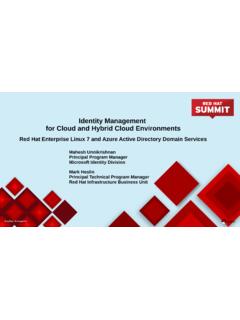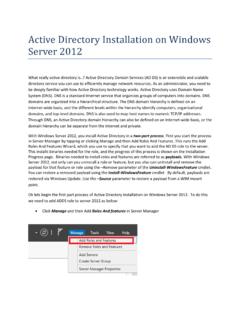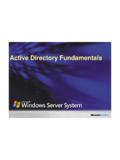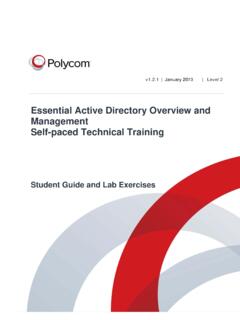Transcription of CHAPTER 3 Designing the Active Directory - FTPOnline.com
1 CHAPTER 3 Designing the Active DirectoryTip&Tec/ Windows Server 2003: Best Practices for Enterprise Deployments / Ruest & Ruest / 222343-x /Blind Folio3:78IN THIS CHAPTER Introducing Active Directory79 Designing the Solution: Using the Active Directory Blueprint87 Putting the Blueprint into Action89 Forest/Tree/ domain Strategy91 Designing the Naming Strategy101 Designing the Production domain OU Structure104 AD and Other Directories112 Service Positioning116 Site Topology127 Schema Modification Strategy133 AD Implementation Plan135 The Ongoing AD Design Process137 Best Practice Summary137 CHAPTER Roadmap138P:\010 Comp\Tip&Tec\343-x\ , March 25, 2003 11:32:02 AMColor profile: Generic CMYK printer profileComposite Default screen79 Active Directory is the core of the Windows Server 2003 network. It is the central componentthat not only serves to provide authentication and authorization, but also administration,information sharing, and information availability.
2 It can be defined as follows: A secure virtual environment where users can interact either with each other or with networkcomponents, all according to the business rules of the enterprise. Quite a change from Windows NT, isn t it? It s no wonder people have not accepted ActiveDirectory (AD) at a neck-breaking pace. It is a paradigm shift that is even more complex than movingfrom character-based computing to the graphical interface. Understanding the breadth of possibilitiesActive Directory brings is the biggest challenge of the enterprise network with first rule you must set for yourself when working to design your Active Directory is Use bestpractices everywhere! Don t try to change the way Active Directory is designed to work no matterwhat you might think at first. Active Directory provides a wealth of opportunities that you will discoveras you implement, use, and operate it. Changes that might make sense according to IT concepts todaymay well have a negative impact on the operation of your Active Directory first step toward the implementation of the enterprise network you could say the major steptoward this implementation is the design and implementation of your Active Directory .
3 Even if youhave already implemented Active Directory and are using it with Windows 2000, a quick review ofhow you design and plan to use Directory services in your network can t hurt, unless you are completelysatisfied with the way your Directory delivers service. In that case, you can move on to CHAPTER 4 toreview your communications infrastructure and begin installing the enterprise , on theother hand, you are using Windows NT and want to move to WS03, the following section is a mustand cannot be overlooked under any Active DirectoryCountless books, articles, and presentations have been written on the subject of Active Directory , and it isnot the intention of this book to repeat them. However, it is important to review a few basic terms andconcepts inherent in Active Directory . Figure 3-1 illustrates the concepts that make up an Active Directory is first and foremost a database. As such it contains aschema a databasestructure.
4 This schema applies to every instance of Active Directory . An instance is defined as anActive Directoryforest. The forest is the largest single partition for any given database person and every device that participates in the forest will share a given set of attributes andobject types. That s not to say that information sharing in Active Directory is limited to a singleforest. Forests can be linked together to exchange certain information, especially with WindowsServer 2003. WS03 introduces the concept offorest trustswhich allow forests to share portions oftheir entire Active Directory database with others and vice you compare the WS03 forest to Windows NT, you can easily see that while NT also includedan identity management database the domain its scope was seriously limited compared to ActiveDirectory. NT could basically store the user or computer name along with passwords and a few rulesaffecting all objects. The basic WS03 AD database includes more than 200 object types and morethan 1,000 attributes by default.
5 You can, of course, add more object types or attributes to thisdatabase. Software products that take advantage of information stored in the Active Directory willTip&Tec/ Windows Server 2003: Best Practices for Enterprise Deployments / Ruest & Ruest / 222343-x / CHAPTER 3P:\010 Comp\Tip&Tec\343-x\ , March 25, 2003 11:32:02 AMColor profile: Generic CMYK printer profileComposite Default screen80 Windows Server 2003: Best Practices for Enterprise DeploymentsTip&Tec/ Windows Server 2003: Best Practices for Enterprise Deployments / Ruest & Ruest / 222343-x / CHAPTER 3also extend the AD schema. Microsoft Exchange, for example, practically doubles the number ofobjects and attributes in a forest because it is integrated to the any database, AD categorizes the objects it contains, but unlike relational databases, ActiveDirectory s database structure is hierarchical. This is because it is based on the structure of the DomainNaming System (DNS), used on the World Wide Web.
6 On the Web, everything is hierarchical. Forexample, the root of Microsoft s Web site is Everything spans from this 3-1 The Active Directory databaseP:\010 Comp\Tip&Tec\343-x\ , March 25, 2003 11:32:07 AMColor profile: Generic CMYK printer profileComposite Default screenMoving to any other section, such as TechNet or MSDN, sends you to pages whose names are basedon the act in the same way except that in a forest, the root point (analogous to the home page)is the root domain . Every AD forest must have at least one domain . Domains act as discrete objectcontainers in the forest. Domains can be regrouped intotrees. Trees are segregated from each otherthrough their DNS name. For example, Microsoft has a multitree forest. Its namespace, the DNSelement that defines the boundaries of the forest, is As such, all domains in this treehave names similar to Microsoft created a second tree when it in its forest. The namespace automatically created a tree and all domains underit are named forest will include at least one tree and at least one domain .
7 The domain is both a securitypolicy and an administration boundary. It is required to contain objects such as users, computers,servers, domain controllers, printers, file shares, applications, and much more. If you have more thanone domain in the forest, it will automatically be linked to all others through automatic transitivetwo-way trusts. The domain is defined as a security policy boundary because it contains rules thatapply to the objects stored in it. These rules can be in the form of security policies or Group PolicyObjects (GPOs). Security policies are global domain rules. GPOs tend to be more discrete and areapplied to specific container objects. While domains are discrete security policy boundaries, theultimate security boundary will always be the contents can be further categorized through grouping object types such asOrganizationalUnits(OUs) orgroups. Organizational Units provide groupings that can be used for administrativeor delegation purposes.
8 Groups are used mainly for the application of security rights. WS03 groupsinclude Universal, which can span an entire forest, Global, which can span domains, or DomainLocal, which are contained in a single domain . OUs are usually used to segregate objects such as users and computers can only reside inside a single OU, but groups can span they tend to contain horizontal collections of objects. An object such as a user can be includedin several groups, but only in a single also have it easier with Active Directory . Working in a distributed forest composed of severaldifferent trees and subdomains can become very confusing to the user. AD supports the notion of userprincipal name (UPN). The UPN is often composed of the username along with the global forest rootname. This root name can be the name of the forest or a special alias you assign. For example, in aninternal forest named , you might use as the UPN, making it simplerfor your users by using yourexternalDNS name for the UPN.
9 Users can log on to any domain orforest they are allowed to by using their UPN. In their local domain , they can just use their usernameif they , Trees, Domains, Organizational Units, Groups, Users, and Computers are all objectsstored in the Active Directory database. As such, they can be manipulated globally or discretely. Thesingle major difference between Active Directory and a standard database is that in addition to beinghierarchical, it is completely decentralized. Most Active Directory databases are also distributedgeographically because they represent the true nature of an enterprise or an a completely distributed database is considerably more challenging than managing adatabase that is located in a single area. To simplify distributed database issues, Active Directoryintroduces the concept ofmultimaster replication. This means that even though the entire forestdatabase is comprised of distributed deposits deposits that, depending on their location in theChapter 3: Designing the Active Directory81 Tip&Tec/ Windows Server 2003: Best Practices for Enterprise Deployments / Ruest & Ruest / 222343-x / CHAPTER 3P:\010 Comp\Tip&Tec\343-x\ , March 25, 2003 11:32:07 AMColor profile: Generic CMYK printer profileComposite Default screenlogical hierarchy of the forest, may or may not contain the same information as others databaseconsistency will be maintained.
10 Through the multimaster structure, AD can accept local changesand ensure consistency by relaying the information or the changes to all of the other deposits in thedomain or the forest. This is one of the functions of the domain Controller object in the only deposits that have exactly the same information in the AD database are two domaincontrollers in the same domain . Each of these data deposits contains information about its owndomain as well as whatever information has been determined to be of forest-wide interest by forestadministrators. At the forest level, you can determine the information to make available to the entireforest by selecting the objects and the attributes from the database schema whose properties you wantto share among all trees and domains. In addition, other forest-wide information includes the databaseschema and the forest configuration, or the location of all forest services . Published information isstored in the Global Catalog.









